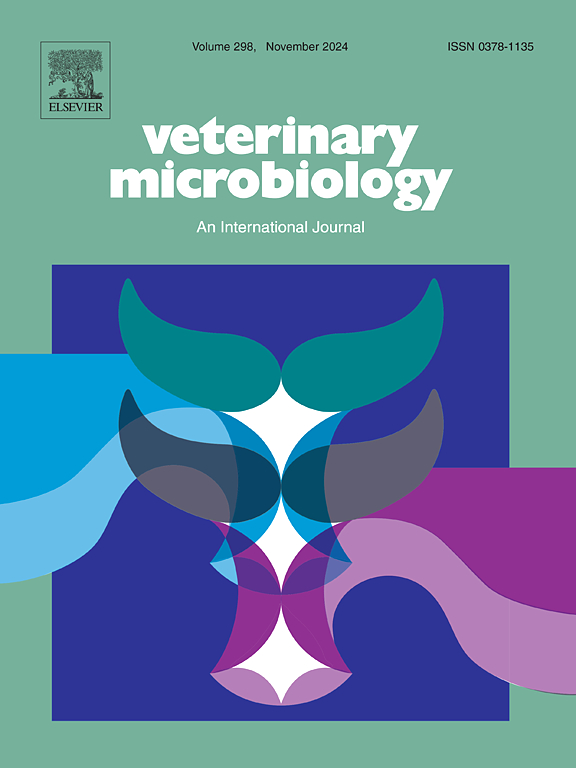Occurrence and diversity of porcine rotavirus groups A, B, C and H in Danish pigs
IF 2.4
2区 农林科学
Q3 MICROBIOLOGY
引用次数: 0
Abstract
Rotaviruses (RVs) are one of the main infectious causes of acute gastroenteritis and are widespread among pigs with enteric disease. RVs are classified into nine groups or species (RVA-RVD and RVF-RVJ) and, to date, four of these (RVA, RVB, RVC, RVD and RVH) have been identified in pigs, with RVA being the most frequent and characterized species. In the present study, reverse transcription quantitative real-time PCR (RT-qPCR) assays specific for RVB, RVC and RVH were designed and validated and used together with a published RVA RT-qPCR assay to evaluate the occurrence of these RV species in rectal swab samples from 90 pigs from 22 Danish sow herds (2–8 pigs per herd). The pigs were 1–35 days of age, and the majority had experienced diarrhea and macroscopic signs of enteritis. Overall, RVs were detected in 81.1 % of the pigs with RVA (37.8 %) and RVB (38.9 %) being predominant, followed by RVC (28.9 %) and RVH (1.1 %). Co-infections with two or three different RV species were observed in 10.0 % and 7.8 % of the pigs, respectively. On herd level, RVs were detected in 95.5 % of the investigated herds with the following distribution: RVA (59.1 %), RVB (54.5 %), RVC (45.5 %) and RVH (4.5 %). In 40.9 % of the herds, more than one RV species was present. While it is known that RVA is frequently found in Danish pigs, this study shows that there is a rich RV diversity in Danish pigs and sow herds.
丹麦猪轮状病毒A、B、C和H群的发生和多样性
轮状病毒(RVs)是引起急性胃肠炎的主要传染病之一,在患有肠道疾病的猪中广泛存在。rv可分为9个类群或种(RVA-RVD和RVF-RVJ),迄今为止,已在猪身上发现了其中4个类群(RVA、RVB、RVC、RVD和RVH),其中RVA是最常见和最具特征的类群。在本研究中,设计并验证了RVB、RVC和RVH特异性的反转录定量实时PCR (RT-qPCR)检测方法,并将其与已发表的RVA RT-qPCR检测方法一起使用,以评估来自22个丹麦母猪群(每个母猪群2-8头猪)的90头猪的直肠棉签样本中这些RV物种的发生情况。猪的年龄为1-35日龄,大多数猪出现腹泻和明显的肠炎症状。总体而言,在81.1 %的猪中检测到RVs,其中RVA(37.8 %)和RVB(38.9 %)居多,其次是RVC(28.9 %)和RVH(1.1 %)。分别有10.0% %和7.8% %的猪同时感染两种或三种不同的RV。在畜群水平上,95.5% %的被调查畜群检测到RVs,其分布为RVA(59.1% %)、RVB(54.5 %)、RVC(45.5% %)和RVH(4.5 %)。在40.9% %的畜群中,存在一个以上的RV物种。虽然已知丹麦猪中经常发现RVA,但本研究表明丹麦猪和母猪群中存在丰富的RVA多样性。
本文章由计算机程序翻译,如有差异,请以英文原文为准。
求助全文
约1分钟内获得全文
求助全文
来源期刊

Veterinary microbiology
农林科学-兽医学
CiteScore
5.90
自引率
6.10%
发文量
221
审稿时长
52 days
期刊介绍:
Veterinary Microbiology is concerned with microbial (bacterial, fungal, viral) diseases of domesticated vertebrate animals (livestock, companion animals, fur-bearing animals, game, poultry, fish) that supply food, other useful products or companionship. In addition, Microbial diseases of wild animals living in captivity, or as members of the feral fauna will also be considered if the infections are of interest because of their interrelation with humans (zoonoses) and/or domestic animals. Studies of antimicrobial resistance are also included, provided that the results represent a substantial advance in knowledge. Authors are strongly encouraged to read - prior to submission - the Editorials (''Scope or cope'' and ''Scope or cope II'') published previously in the journal. The Editors reserve the right to suggest submission to another journal for those papers which they feel would be more appropriate for consideration by that journal.
Original research papers of high quality and novelty on aspects of control, host response, molecular biology, pathogenesis, prevention, and treatment of microbial diseases of animals are published. Papers dealing primarily with immunology, epidemiology, molecular biology and antiviral or microbial agents will only be considered if they demonstrate a clear impact on a disease. Papers focusing solely on diagnostic techniques (such as another PCR protocol or ELISA) will not be published - focus should be on a microorganism and not on a particular technique. Papers only reporting microbial sequences, transcriptomics data, or proteomics data will not be considered unless the results represent a substantial advance in knowledge.
Drug trial papers will be considered if they have general application or significance. Papers on the identification of microorganisms will also be considered, but detailed taxonomic studies do not fall within the scope of the journal. Case reports will not be published, unless they have general application or contain novel aspects. Papers of geographically limited interest, which repeat what had been established elsewhere will not be considered. The readership of the journal is global.
 求助内容:
求助内容: 应助结果提醒方式:
应助结果提醒方式:


